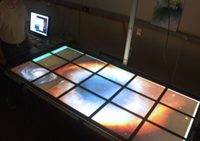EVL’s Lambda Table puts science at your fingertips
October 15th, 2007
Categories: Applications, Devices, Education, Museums, Software, User Groups, Visualization, VR

About
by Eli Ortiz
Chicago Flame On-line
Issue date: 10/15/07 Section: Features
The Electronic Visualization Laboratory (EVL) hosted an open house for perspective students and their families on Monday. Throughout the open house, EVL discussed the many projects that are currently being researched and developed. One project that stood out from the rest is the Lambda Table, a table that displays an image or program that can be manipulated like a touch-screen computer.
The Lambda Table has been in development by the EVL for over two years now. This table consists of six 30-inch Dell LCD monitors which combined has a resolution of over 24 million pixels. This results in a very sharp image in a relatively large area. What makes the Lambda Table so unique is how it incorporates its high resolution with its hands-on applications.
There are many applications that are currently being developed for the Lambda Table. These applications include high-resolution microscopy images, aerial maps, the Visible Human and the Rain Table.
“The Visible Human application can be used in replacement of expensive cadavers,” said Senior Research Programmer Lance Long.
This application allows the user to dissect a human body without having to actually touch a body. Once a cadaver has been used, it cannot be used again. The Visible Human application allows students to do as much exploring and learning as necessary without having to find a replacement cadaver each time.
The Visible Human application and the other applications are controlled by using a system of cameras and infrared light to track pucks with reflective markers. These pucks are similar to computer mice.
“Each of these pucks has a special pattern of markers,” said EVL Ph.D. graduate student Hyejung Hur. Hur is currently working on the tracking of each device to make sure the cameras see each device accurately. She explained that one puck may be used to zoom in on an area of a map while another is used to pan and rotate the map. It is important these pucks can be distinguished and their locations are seen on the table accurately. These pucks and infrared cameras allow the user to interact with the applications on the Lambda Table.
The Rain Table is an application in which any user can observe what would happen when rain falls in a certain area. Dmitri Svistula, an EVL graduate student, is responsible for the development of the Rain Table. This application allows the user to move around the puck on the table, causing rain to fall on an accurate topographical map of a certain area. The rain then flows according to the location of hills, ridgelines, and rivers. The application simulates the path in which the rainwater would travel and eventually where the water would drain.
This application is beneficial when dealing with natural disasters. It allows the user to see what areas might be in danger when flooding or a heavy rain occurs.
Currently the Rain Table application is being developed for the Minnesota Science Museum. The National Science Foundation is funding the Rain Table. This application hopes to educate the public on erosion and also help prevent natural disasters. The Rain Table will be the first application that will be put to use in coordination with the Lambda Table at a public museum.